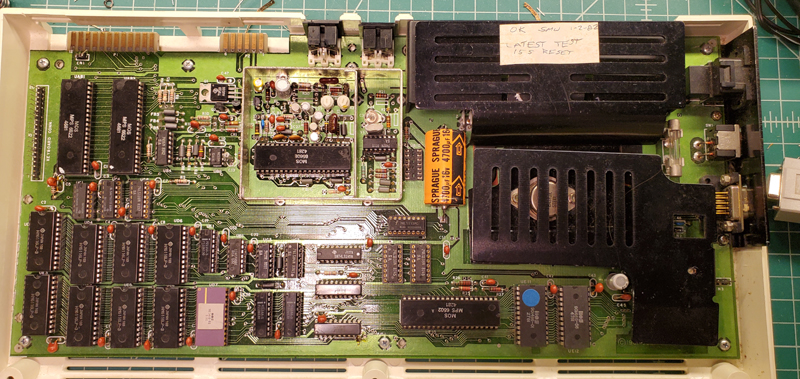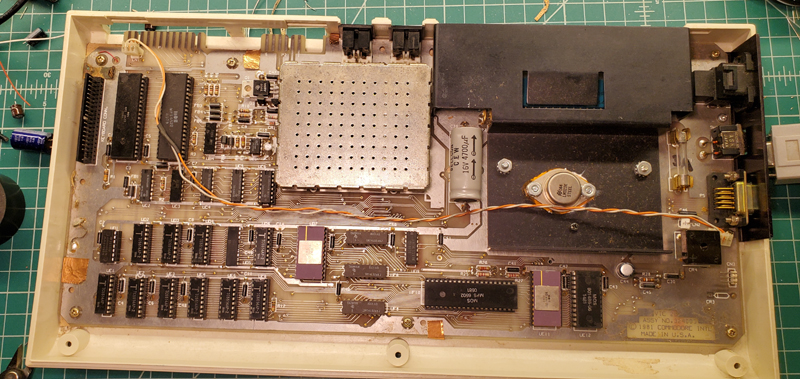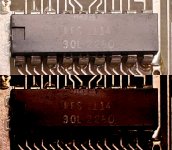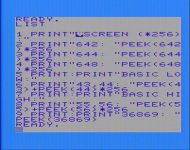CommodoreZ
Experienced Member
Howdy,
A few weeks ago at VCF East, I spoke with Robert "Bob" Russell, one of the VIC Commandos. I don't know what convinced him to do so, but he gave me a pair of later VIC-20 prototype boards.
First, the 16K VIC-20 Prototype. This machine is an internal prototype from Commodore of a VIC-20 variant that never made it to production. Some folks call it a VIC-16, but we have no official designation for it.
Back to the prototype, this seems to be the only survivor of the project. It was supposed to be sent out for FCC certification RF testing, but whether or not it made it that far is unknown. The machine does not include the top half of the case or keyboard, much less a serial number. It's based on the common 324003 production motherboard, with a few ICs rearranged to make room for 8x 6116 SRAMs in place of 8 of the existing 2114 SRAMs. If you pay close attention, you'll note that it has 17K of RAM, not 16K, plus the color RAM. When you start the machine, it reports 15871 bytes free. The power, 6522, CPU, regulator section, and VIC chip/RF cage otherwise look like a 324003. There are three stickers with notes on the system, and here's my best interpretation of what they say:

The brown one is 324003 that has no solder mask or silkscreen, and was intended as an internal RAM test board at Commodore. Bob said that it was Jack Tramiel's idea to test the viability of Russian or Eastern Bloc 2114 SRAM, however this appears to have 10 Toshiba 2114s, and one unsocketed 2114 of indistinct marking.
I've taken to calling it the "brown board" because it has no solder mask or silk screen, and is just tinned copper on top of vaguely brown fiberglass PCB. Apart from the PCB, this board sports an early production heatsink for the 5V regulator, typically only seen on early Japanese VIC-1001s before they realized it burned users who reached in the cartridge port.
Bob says that Jack Tramiel wanted to test the viability of cheap Russian or Eastern Bloc 2114 SRAM. This machine was an internal engineering test bench to that end. However, the SRAM on board does not corroborate this claim. The 10 socketed 2114s appear to be made by Toshiba, and the remaining one is both soldered in place and has indistinct markings. It has no top half of the case or keyboard, but it does have a serial number of V1002001. It has a beautiful gold and purple ceramic MOS 6560 VIC chip, and some minor mods to the analog circuitry. The ROMs on board were dumped and matched to standard production VIC-20 ROMs. I've tried dialing in the color phase, but it's finicky -- otherwise the brown board works fine.

I've put all of my photographs and details I've discovered here:
https://www.commodorez.com/vic.html

The 16K machine was previously documented on Secret Weapons of Commodore - Super VIC.
A few weeks ago at VCF East, I spoke with Robert "Bob" Russell, one of the VIC Commandos. I don't know what convinced him to do so, but he gave me a pair of later VIC-20 prototype boards.
First, the 16K VIC-20 Prototype. This machine is an internal prototype from Commodore of a VIC-20 variant that never made it to production. Some folks call it a VIC-16, but we have no official designation for it.
Back to the prototype, this seems to be the only survivor of the project. It was supposed to be sent out for FCC certification RF testing, but whether or not it made it that far is unknown. The machine does not include the top half of the case or keyboard, much less a serial number. It's based on the common 324003 production motherboard, with a few ICs rearranged to make room for 8x 6116 SRAMs in place of 8 of the existing 2114 SRAMs. If you pay close attention, you'll note that it has 17K of RAM, not 16K, plus the color RAM. When you start the machine, it reports 15871 bytes free. The power, 6522, CPU, regulator section, and VIC chip/RF cage otherwise look like a 324003. There are three stickers with notes on the system, and here's my best interpretation of what they say:
OK SMW 1-2-82
LATEST TEST
155 RESET
BAD 1/5/82 RAS
I'm not sure what the significance of 155 RESET is, but I have noticed this machine takes longer to display a READY prompt than most other VICs. Considering it does in fact run, whatever was wrong with the 6560 may have warranted a replacement. The ROMs on board were dumped and were confirmed to match production VIC-20 ROMs bit for bit. It has an MOS 6560E VIC chip, which is odd because the E suffix only seems to be present on PAL VICs. If you've seen an MOS6560E in something else, VIC or otherwise, I'd love to hear about it. The board is marked with a unique assembly number of 3016006.155
LARGE FUSE
BI BAD 6560

The brown one is 324003 that has no solder mask or silkscreen, and was intended as an internal RAM test board at Commodore. Bob said that it was Jack Tramiel's idea to test the viability of Russian or Eastern Bloc 2114 SRAM, however this appears to have 10 Toshiba 2114s, and one unsocketed 2114 of indistinct marking.
I've taken to calling it the "brown board" because it has no solder mask or silk screen, and is just tinned copper on top of vaguely brown fiberglass PCB. Apart from the PCB, this board sports an early production heatsink for the 5V regulator, typically only seen on early Japanese VIC-1001s before they realized it burned users who reached in the cartridge port.
Bob says that Jack Tramiel wanted to test the viability of cheap Russian or Eastern Bloc 2114 SRAM. This machine was an internal engineering test bench to that end. However, the SRAM on board does not corroborate this claim. The 10 socketed 2114s appear to be made by Toshiba, and the remaining one is both soldered in place and has indistinct markings. It has no top half of the case or keyboard, but it does have a serial number of V1002001. It has a beautiful gold and purple ceramic MOS 6560 VIC chip, and some minor mods to the analog circuitry. The ROMs on board were dumped and matched to standard production VIC-20 ROMs. I've tried dialing in the color phase, but it's finicky -- otherwise the brown board works fine.

I've put all of my photographs and details I've discovered here:
https://www.commodorez.com/vic.html

The 16K machine was previously documented on Secret Weapons of Commodore - Super VIC.



